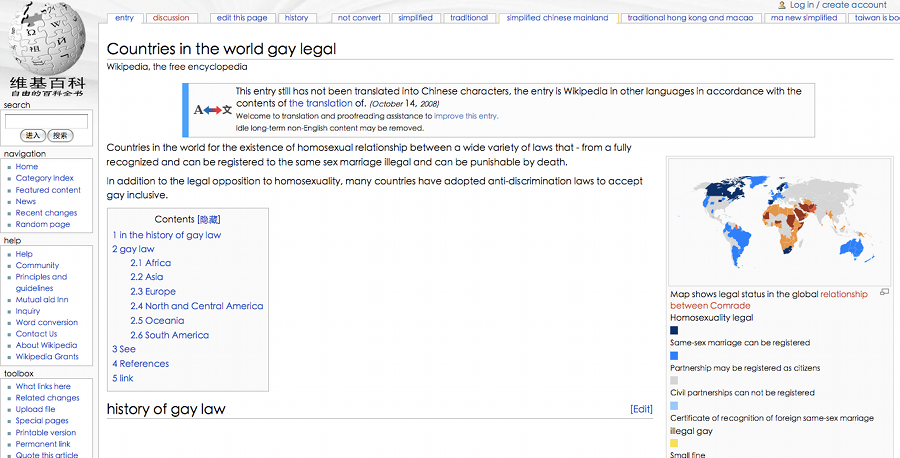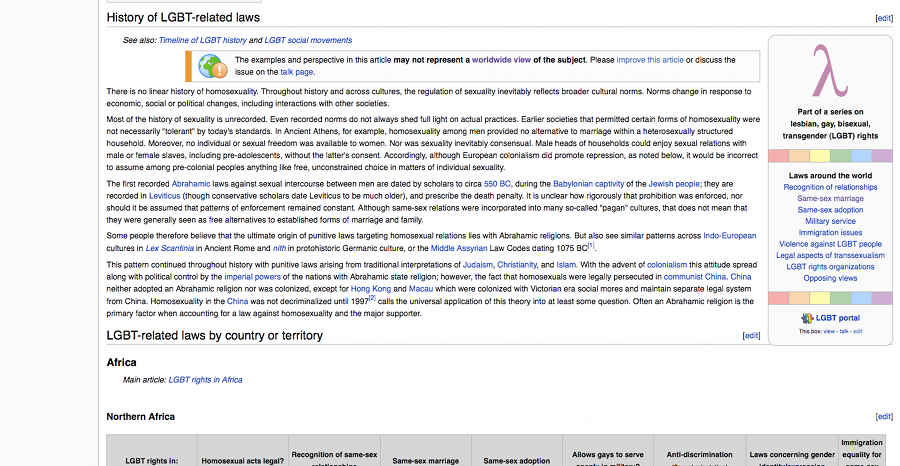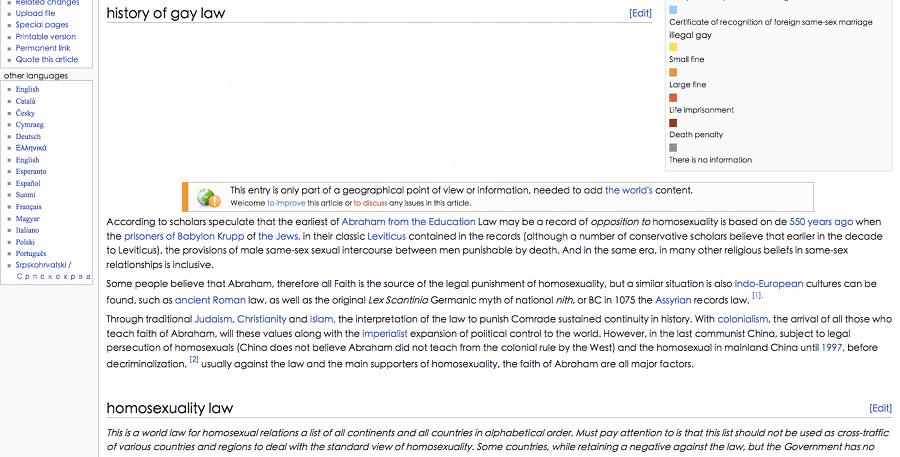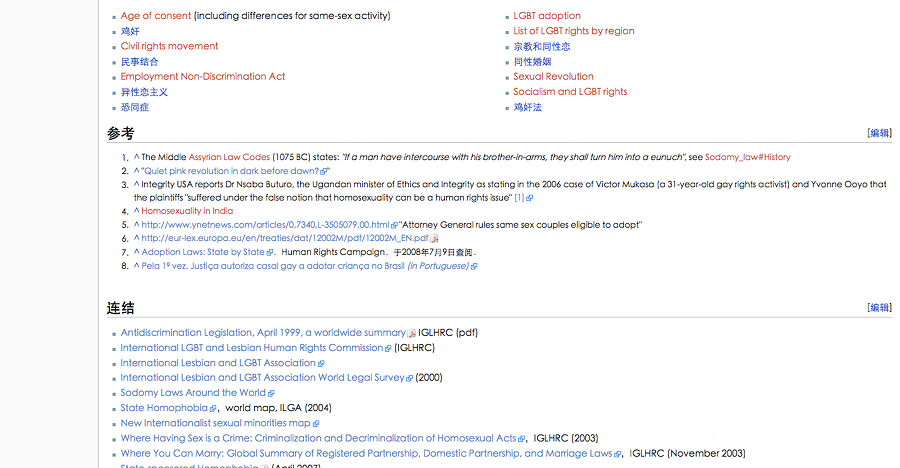You are here: Foswiki>Dmi Web>SummerSchool2009>ControversyGeneratorPlacesOfControversies>GayRights (28 Aug 2009, bramnijhof)Edit Attach
Gay rights in different language Wikipedias
- go through the pages in different language Wikipedias that have an entry for "Gay Rights"- three parts:
1. Word count [we have used the word count as an indication of the comprehensiveness of an article]: - select all text in the article. Copy the text into a wordprocessor like Microsoft Word. Use the word count option to calculate the amount of words - make an Excel sheet where we input the wordcount for the "Gay Rights" article lengths in different languages
- put them in descending order
- put into Bubblelines tool [http://tools.issuecrawler.net/beta/bubbleline/] in order to produce relative size bubbles
2. Mapping the anonymous users:
- put the English, Spanish and Chinese "Gay Rights" article IPs into the Wikipedia IP Scraper tool [http://marijn.digitalmethods.net/scrapers/geo] to collect the anonymous contributors
- make a map of all the IPs
- make map of the unique [users who only edited once] IPs
3. Warning templates:
- collect the warning templates
- make an Excel sheet that describes the warnings in reference to the language of the entry
- NB: we note that the Chinese entry appears to be a translation of the English version [see appendix section for screenshots of the Google translation of the Chinese page and the English page which has been subsequently modified] - create a table that illustrates the findings - the results are accessible in the PDF below: Case_study_Gay_rights_in_different_language_Wikipedias.pdf
Findings
- Word count: what does it says? The amount of words can say something about how much attention is spend on the issue.
- Mapping the anonymous users: the map of IP adresses of the Spanish "Gay Rights" article shows that most of the countries are countries where Spanish is their main language.
Appendix: Chinese 'Gay rights' entry
- 'Gay rights' entry on Wikipedia.org: http://zh.wikipedia.org/wiki/%E4%B8%96%E7%95%8C%E5%90%84%E5%9C%8B%E5%90%8C%E6%80%A7%E6%88%80%E6%B3%95%E5%BE%8B
- 'Gay rights' entry translated with Google Translate: http://74.125.79.132/translate_c?hl=nl&ie=UTF-8&sl=zh-CN&tl=en&u=http://zh.wikipedia.org/wiki/%25E4%25B8%2596%25E7%2595%258C%25E5%2590%2584%25E5%259C%258B%25E5%2590%258C%25E6%2580%25A7%25E6%2588%2580%25E6%25B3%2595%25E5%25BE%258B&prev=_t&rurl=translate.google.com&usg=ALkJrhjAwGp8RTYt2PcuzcCeqzN4TqQDrg
- To translate a page, go to Google Translate: http://translate.google.com/translate_t#. Copy and paste the URL of the page for translation. Select the right language which to translate from and click on 'translate'.
- The warning template for the entry states that the contents have not yet been translated into Chinese. The entry is only a conversion from non-Chinese content. We have compared this entry to the English entry and suspect that the conversion was made on the basis of the English page. Also, some of the content in the Chinese page is in English, especially the references.
 Chinese 'gay rights' entry (translated into English with Google Translate). There is a warning because the content is not yet translated in Chinese.
http://74.125.79.132/translate_c?hl=nl&ie=UTF-8&sl=zh-CN&tl=en&u=http://zh.wikipedia.org/wiki/%25E4%25B8%2596%25E7%2595%258C%25E5%2590%2584%25E5%259C%258B%25E5%2590%258C%25E6%2580%25A7%25E6%2588%2580%25E6%25B3%2595%25E5%25BE%258B&prev=_t&rurl=translate.google.com&usg=ALkJrhjAwGp8RTYt2PcuzcCeqzN4TqQDrg
Chinese 'gay rights' entry (translated into English with Google Translate). There is a warning because the content is not yet translated in Chinese.
http://74.125.79.132/translate_c?hl=nl&ie=UTF-8&sl=zh-CN&tl=en&u=http://zh.wikipedia.org/wiki/%25E4%25B8%2596%25E7%2595%258C%25E5%2590%2584%25E5%259C%258B%25E5%2590%258C%25E6%2580%25A7%25E6%2588%2580%25E6%25B3%2595%25E5%25BE%258B&prev=_t&rurl=translate.google.com&usg=ALkJrhjAwGp8RTYt2PcuzcCeqzN4TqQDrg
 English 'gay rights' entry. In the English version is a warning that the article may not represent a worldwide view. http://en.wikipedia.org/wiki/Gay_rights
English 'gay rights' entry. In the English version is a warning that the article may not represent a worldwide view. http://en.wikipedia.org/wiki/Gay_rights
 Chinese 'gay rights' entry. Just like the English version the Chinese version has the same warning as the English version about the representation of a worldwide view. Compare the paragraph about with the English version and note that the content of the Chinese version is the same as the English version but shorter.
http://74.125.79.132/translate_c?hl=nl&ie=UTF-8&sl=zh-CN&tl=en&u=http://zh.wikipedia.org/wiki/%25E4%25B8%2596%25E7%2595%258C%25E5%2590%2584%25E5%259C%258B%25E5%2590%258C%25E6%2580%25A7%25E6%2588%2580%25E6%25B3%2595%25E5%25BE%258B&prev=_t&rurl=translate.google.com&usg=ALkJrhjAwGp8RTYt2PcuzcCeqzN4TqQDrg
Chinese 'gay rights' entry. Just like the English version the Chinese version has the same warning as the English version about the representation of a worldwide view. Compare the paragraph about with the English version and note that the content of the Chinese version is the same as the English version but shorter.
http://74.125.79.132/translate_c?hl=nl&ie=UTF-8&sl=zh-CN&tl=en&u=http://zh.wikipedia.org/wiki/%25E4%25B8%2596%25E7%2595%258C%25E5%2590%2584%25E5%259C%258B%25E5%2590%258C%25E6%2580%25A7%25E6%2588%2580%25E6%25B3%2595%25E5%25BE%258B&prev=_t&rurl=translate.google.com&usg=ALkJrhjAwGp8RTYt2PcuzcCeqzN4TqQDrg
 Chinese 'gay rights' entry. There is English language between the Chinese and there are English references. http://zh.wikipedia.org/wiki/%E4%B8%96%E7%95%8C%E5%90%84%E5%9C%8B%E5%90%8C%E6%80%A7%E6%88%80%E6%B3%95%E5%BE%8B
-- BramNijhof - 10 Jul 2009
Chinese 'gay rights' entry. There is English language between the Chinese and there are English references. http://zh.wikipedia.org/wiki/%E4%B8%96%E7%95%8C%E5%90%84%E5%9C%8B%E5%90%8C%E6%80%A7%E6%88%80%E6%B3%95%E5%BE%8B
-- BramNijhof - 10 Jul 2009 Edit | Attach | Print version | History: r6 < r5 < r4 < r3 | Backlinks | View wiki text | Edit wiki text | More topic actions
Topic revision: r5 - 28 Aug 2009, bramnijhof
 Copyright © by the contributing authors. All material on this collaboration platform is the property of the contributing authors.
Copyright © by the contributing authors. All material on this collaboration platform is the property of the contributing authors. Ideas, requests, problems regarding Foswiki? Send feedback


